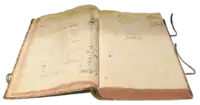Fixed asset
Fixed assets, also known as long-lived assets, tangible assets[1] or property, plant and equipment (PP&E), is a term used in accounting for assets and property that cannot easily be converted into cash. This can be compared with current assets such as cash or bank accounts, described as liquid assets. In most cases, only tangible assets are referred to as fixed.
While IAS 16 (International Accounting Standard) does not define the term "Fixed Assets",[2] it is often colloquially considered a synonym for Property, Plant and Equipment. IAS 16.6 Definitions states: "Property, plant and equipment are tangible items that: (a) are held for use in the production or supply of goods or services, for rental to others, or for administrative purposes; and (b) are expected to be used during more than one period." In modern financial accounting usage, the term "fixed assets" is considered ambiguous. Instead the term "non-current assets" (used in both the IFRS [3]and US GAAP XBRL[4] reporting taxonomies) is preferred when referring to assets that will not be liquidated in the current fiscal period. Specific non-current assets (Property, plant and equipment, Investment property, Goodwill, Intangible assets other than goodwill, etc). should be referred to by name[5].
Fixed assets belong to one of 2 types:
"Freehold Assets" – assets which are purchased with legal right of ownership and used,
and "Leasehold Assets" – assets used by owner without legal right for a particular period of time.
| Part of a series on |
| Accounting |
|---|
 |
A fixed asset can also be defined as an asset not directly sold to a firm's consumers/end-users.
As an example, a baking firm's current assets would be its inventory (in this case, flour, yeast, etc.), the value of sales owed to the firm via credit (i.e. debtors or accounts receivable), cash held in the bank, etc. Its non-current assets would be the oven used to bake bread, motor vehicles used to transport deliveries, cash registers used to handle cash payments, etc. While these non-current assets have value, they are not directly sold to consumers and cannot be easily converted to cash.
These are items of value that the organization has bought and will use for an extended period of time; fixed assets normally include items such as land and buildings, motor vehicles, furniture, office equipment, computers, fixtures and fittings, and plant and machinery. These often receive favorable tax treatment (depreciation allowance) over short-term assets.
It is pertinent to note that the cost of a fixed asset is its purchase price, including import duties and other deductible trade discounts and rebates. In addition, cost attributable to bringing and installing the asset in its needed location and the initial estimate of dismantling and removing the item if they are eventually no longer needed on the location.
The primary objective of a business entity is to make profit and increase the wealth of its owners.[6] In the attainment of this objective it is required that the management will exercise due care and diligence in applying the basic accounting concept of "Matching Concept". Matching concept is simply matching the expenses of a period against the revenues of the same period.
The period of use of assets, in the generation of revenue, is usually more than a year, i.e. long term. It is therefore obligatory that in order to accurately determine the Net Income or profit for a period, depreciation be applied on the total value of the asset and charged against the same revenue of the same period. This is essential in the prudent reporting of the net revenue for the entity in the period.
Net book value of an asset is basically the difference between the historical cost of that asset and its associated depreciation. From the foregoing, it is apparent that in order to report a true and fair of the financial jurisprudence of an entity it is relatable to record and report the value of fixed assets at its net book value. Apart from the fact that it is enshrined in Standard Accounting Statement (SAS) 3 and IAS 16 that value of asset should be carried at the net book value, it is the best way of consciously presenting the value of assets to the owners of the business and potential investor.
Depreciating a fixed asset
Depreciation is, simply put, the expense generated by the uses of an asset. It is the wear and tear of an asset or diminution in the historical value owing to usage. Further to this; it is the cost of the asset less any salvage value over its estimated useful life. A fixed asset can be depreciated using the straight line method which is the most common form of depreciation. Tax depreciation is commonly calculated differently than depreciation for financial reporting.
See also
References
| Library resources about Fixed asset |
- Dyckman, Intermediate Accounting, Revised Ed. (Homewood IL: Irwin, Inc. 1992),195.
- http://eifrs.ifrs.org/eifrs/bnstandards/en/IAS16.pdf
- https://bigfoot.corefiling.com/yeti/resources/yeti-gwt/Yeti.jsp#tax~(id~207*v~2869)!con~(id~9206108)!net~(a~2610*l~771)!lang~(code~en)!path~(g~1117510*p~0_0_0)!rg~(rg~1*p~1)
- http://xbrlview.fasb.org/yeti/resources/yeti-gwt/Yeti.jsp#tax~(id~174*v~6430)!con~(id~4379966)!net~(a~3474*l~832)!lang~(code~en-us)!path~(g~99043*p~0_0_2_0_1)!rg~(rg~32*p~12)
- https://bigfoot.corefiling.com/yeti/resources/yeti-gwt/Yeti.jsp#tax~(id~207*v~2869)!con~(id~9206108)!net~(a~2610*l~771)!lang~(code~en)!path~(g~1117510*p~0_0_0)!rg~(rg~1*p~1)
- Business